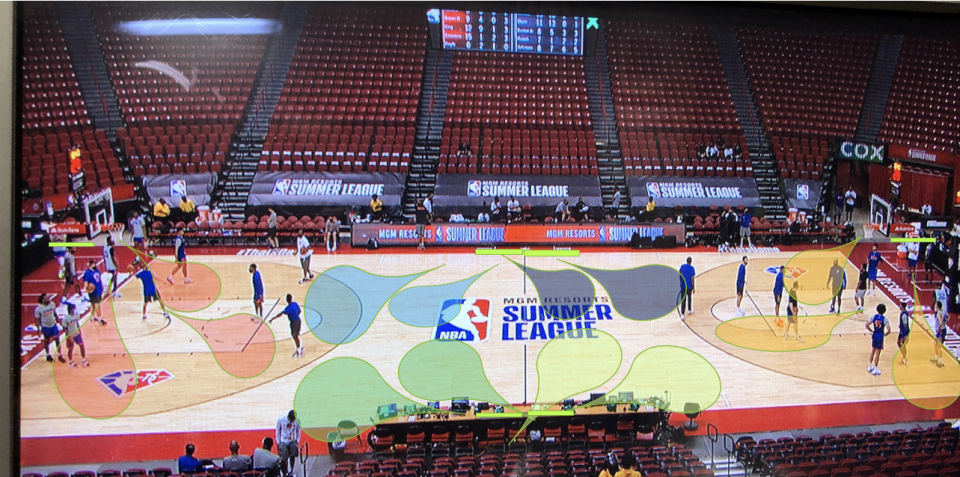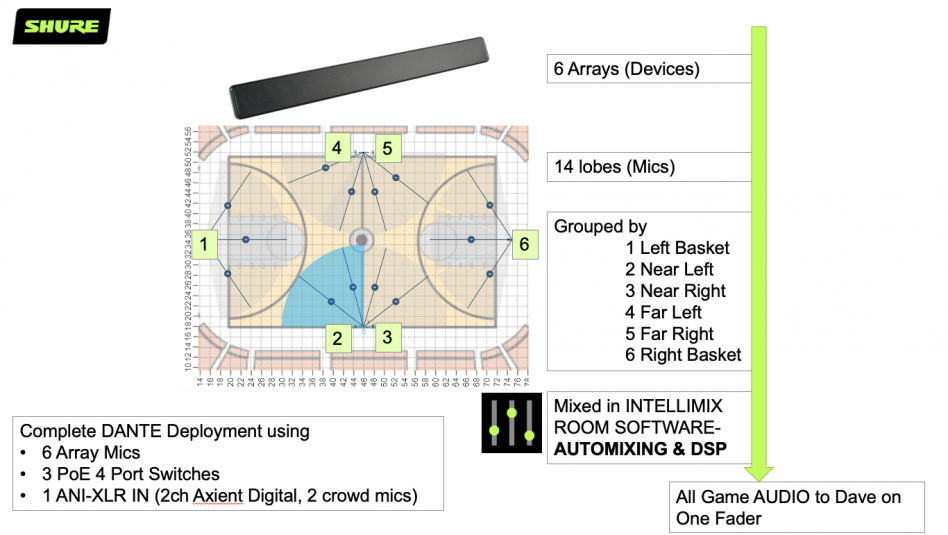NBA Summer League Audio Pushes the Envelope
Turner expands use of multi-lobe arrays; Q5X aims for smaller
Story Highlights
The NBA Summer League is basketball’s Skunk Works, and this year’s series at the Thomas & Mack Center and Cox Pavilion in Las Vegas showed off some really cool innovations that viewers will likely be hearing this fall.
Dave Grundtvig, senior audio supervisor, remote operations, Turner Sports, has significantly expanded the application he developed for Shure’s MXA710 microphone array. Originally created for the corporate–conference-room market, the array comprises a series of in-line transducers that, in conjunction with the MXA710’s proprietary IntelliMix DSP and automixing technology, can automatically steer its microphone lobes based on programmable parameters. For instance, it can be tuned to listen for certain types of sounds or frequencies and either enhance or reject them.
“This time,” Grundtvig says, “we applied the microphone arrays to the entire court, instead of just on the baskets.”

A total of six arrays were distributed around Las Vegas’s Thomas & Mack Center and Cox Pavilion for NBA Summer League.
A total of six arrays were deployed: two at mid court on each side of the court, one array under each basket, and one microphone on each net. Choosing to activate a different number of transducers in each array (under-basket arrays, for instance, used three lobes: one at the key, one at the near corner, one at the far corner), A total of 16 mic lobes came back from the court and were processed through the IntelliMix software, which, based on programmed function parameters (thresholds for gating and steering, for example), created a mix of effects managed by a combination of DSP and gain sharing. It’s an automatic mixing process in which the total gain of the system remains constant: each individual input channel is attenuated by an amount, in decibels, equal to the difference between the channel’s level and the sum of all channel levels.
Selective noise reduction was also applied, also through the IntelliMix software. When a particular combination of frequency and SPL is recognized by a mic lobe tuned for it, that “noise” is attenuated or removed, leaving more space for desired sounds. For instance, says Grundtvig, effects sound — music from the PA, cheers — that gets into an announcer’s microphone can be automatically and instantly reduced, helping keep the announcer’s audio intelligible.
“Basically, I’m trying to capture subtle audio in a hostile environment,” he explains. “If I can get a 2- to 3-dB reduction in PA sound in the effects or announcer mics, I can help make them both more pronounced and defined in the overall mix.”
Use of automated and programmable systems like these, he says, allows smoother transitions between sounds as games progress, as well as creating a broadcast soundscape that’s easier for the A1 to shape.
It could also, he acknowledges, reduce the need for live submixers in some circumstances. “But, really, the goal is to create space, so that the [A1] isn’t constantly focusing on manually mixing so many faders. That gives you the space to refine everything else in the mix.”
Beyond Basketball
The approach can be applied to other sports. Grundtvig says he’s still trying to interest Major League Baseball in the concept of multi-lobe arrays versus the more traditional deployment of many individual shotgun or lavalier microphones, for instance. In addition to streamlining the mixing process, it can also make more-productive use of personnel resources — the time it takes to emplace one array versus multiple microphones — and signal transport, which can be compacted to a single Cat 5 cable versus individual copper wires for each microphone. The implications are considerable for leagues and broadcasters, both of which constantly seek cost-reduction techniques, and for pro-audio manufacturers, which can market to sports the products developed for other verticals.
Grundtvig also predicts that Turner Sports will continue its ongoing experiments with Dolby Atmos for NBA broadcasts.
“We’ve done a handful of these over the last year, with the audio going back just to Atlanta and to DirecTV,” he says, noting that the infrastructure flux at the network’s Atlanta facility in the wake of AT&T’s spinoff of TBS parent WarnerMedia will require more time to fully accommodate Atmos operations. “It’s still a proof-of-concept at this point, and it will take some time to fully ramp up. But it’s showing a lot of promise.”
Q5X Focuses on ‘Safe and Non-Invasive’ Techniques
Also onsite at the NBA Summer League was Q5X, which created its own microphone-transmitter category with the small and light PlayerMic, which was developed initially for the NBA and is soft-sided to minimize the potential for injury in case of a fall. According to Q5X CEO Paul Johnson, there’s nothing to announce just yet: “We were there, as usual, exploring new ways to enhance player, coach, and referee audio in a way that is both safe and non-invasive for the athlete. As you know, it’s an ever-evolving pursuit.”

